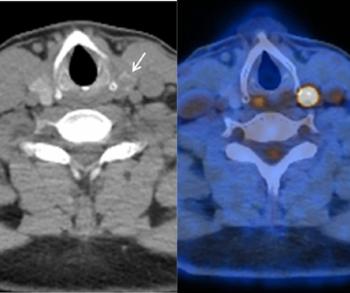
Guidelines for Use of the PSMA-PET Scan for Prostate Cancer
Two experts review SNMMI (Society of Nuclear Medicine and Molecular Imaging) guidelines for use of PSMA PET scans in prostate cancer detection, as well as awareness about this new modality within the patient community.
Episodes in this series

Umesh D. Oza, MD: You know what the SNMMI [Society of Nuclear Medicine and Molecular Imaging] have come out with some guidelines of when to do these studies now in my world [and] in your world. We’re both practicing in clinical practice and some academic. But we have to go by guidelines, because in the end of the day. Insurance companies are going to rely on that for approval. So why don’t we talk about the guidelines and the indications. Let’s [take a] deep dive into these guidelines and [discuss] when a PSMA PET-CT may be indicated according to our society.
Jaideep S. Sohi, MD: Interesting question, because in the past several months, at the annual AUA [American Urological Association] meeting in June in Chicago, the NCCN [National Comprehensive Cancer Network] guidelines, the Society of Nuclear Medicine and Medical Imaging guidelines all now have come out with statements that you can replace conventional imaging, CT and bone scan, with PSMA PET for initial staging and researching purposes. So, in other words, now we have guidelines that have been updated as recently as this year, given the benefits of PSMA PET, given the clarity of diagnosis of PSMA PET. And now you’re able to utilize this modality in lieu of the previously mentioned imaging modalities. How has that impacted your clinical practice? And what are you using with regard to guidelines?
Umesh D. Oza, MD: Absolutely, I would [use it]. It’s busy, all of a sudden these scans are being done on these patients who otherwise didn’t have access to this PSMA-PET. [The number of ordered] bone scans have definitely gone down as far as I can see in our practice, the number of studies being ordered. We still use it for other cancers or troubleshooting lesions, but, certainly, I have seen less bone scans being ordered. On the CT side, it’s hard for us to gauge because I think CT is so prevalent that it’s hard. Maybe there’s a blip, but I don’t know if that’s a trend, or just a small little change from month to month. But absolutely, PSMA, we have folks, and we’ll talk a little bit about patient awareness about this.… There’s always a subset of patients who are very aware of their care, and what’s out there, and what they can ask for, what’s the best test or best treatment, and they like to look that up. And I think doctors, on the whole, like patients like that coming to them with information well thought out and asking about their care. And we’re seeing a little bit of that push from our oncologists, saying, “Yeah, our patients are asking for this. Can we get it?” So availability and distribution of the tracer is different. We’ll touch on the gallium vs the F 18–based tracers or radio isotopes. We can touch on that. But I’ve definitely seen it. There’s no doubt about it that almost it used to be 1 day a week, because [only the pharmacy can] deliver it, and a few months ago [it became] 2 or 3 days a week, and now it’s every day we’re seeing PSMA PET-CTs being used, and not just for staging, but restaging, but even after treatment, like we’re seeing in what we experience in the lymphoma world, where [when they’re] staging, they’ll give a few doses, or maybe 1 or 2 doses, and…if that those lymph nodes improve after 1 or 2 doses, [it’s] a great positive prognostic indicator for this patient. So we’re seeing it very early as long as insurance is approving it. Or if they’re on a trial, we’re seeing frequent PSMA PET-CTs being ordered. I’m sure you’re seeing the same thing.
Jaideep S. Sohi, MD: Yes, [that’s a] really interesting observation and perspective. Have you seen the utilization of PSMA PET vary by risk group?
Umesh D. Oza, MD: I have. When we dictate, we get all the clinical information. And obviously I’ve not seen any [with] Gleason [scores of] 6 or less, very low-risk patients. So we’re seeing the higher-risk patients. I’ve seen more Gleason 9s than I’ve ever seen ordered on a bone scan. We’re seeing those patients show up more often. And down to 7, I would say, we’re still seeing the [Gleason] 7s, Gleason 3 + 4, 4 + 3 [types of] 7s. [That’s what] we’re seeing. So I’d like to see more of that, because I think the guidelines say that we can do it in those patients. And in the past we would not see much disease on there. But, certainly, we’re seeing that in the lower risk, and maybe that’s something in the future [where] we may see even the lower risk [patients], [the] very low risk, low-risk patients with Gleason 6 [or lower scores for whom] this PSMA still could be helpful. We don’t have the data. It would be interesting, because I’m not seeing that. Are you seeing patients in that in that subgroup being imaged yet?
Jaideep S. Sohi, MD: No, I think not as of now. I think the guidelines and the appropriateness criteria currently is, I believe, unfair about intermediate risk and higher. But do I think that may change? I think the answer is probably yes. Especially as we get more data on PSMA imaging at an earlier time point in the patient’s journey. Perhaps as our technology improves with regard to resolution, so [it’s] definitely a space to watch.
Umesh D. Oza, MD: Absolutely. I [spoke about] patients. Have you seen any changes out in the community hospitals? Have you seen any outreach? Are you seeing anything? People talking about this in the world, about prostate staging and restaging with the PSA as far as on the public side?
Jaideep S. Sohi, MD: I think we would be shocked in a pleasant way, definitely in a pleasant way. There are a lot of patient prostate cancer support groups and awareness groups where the advocates and the patients are very knowledgeable. They’re up-to-date on the literature, they’re up-to-date on the imaging. I believe that some of the imaging is being driven by patients who’ve become aware of this new impact [of this] modality. So the answer is, yes, I believe that there [are people talking about it]. Is there room for higher, greater awareness? Absolutely. A lot of work has to be done. But with regard to seeing referral requests that have been impacted by patients’ input, the answer is yes.
Transcript is AI-generated and edited for clarity and readability.
Newsletter
Stay at the forefront of radiology with the Diagnostic Imaging newsletter, delivering the latest news, clinical insights, and imaging advancements for today’s radiologists.






























